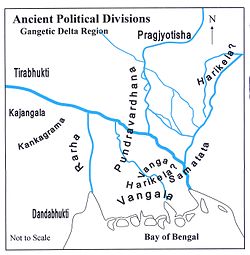Varman (Yadava) Dynasty
Varman Dynasty | |||||||||
|---|---|---|---|---|---|---|---|---|---|
| 1035 A.D–1150 A.D | |||||||||
 | |||||||||
| Capital | Bikrampur, Champapuri | ||||||||
| Common languages | Sanskrit Prakrit | ||||||||
| Religion | Hinduism | ||||||||
| Government | Monarchy | ||||||||
| Maharaja | |||||||||
• Unknown | Vajra Varman | ||||||||
• 1046-1085 | Jata Varman | ||||||||
• 1085-1131 | Hari Varman | ||||||||
• Unknown | Samala Varman | ||||||||
• Unknown | Bhoja Varman | ||||||||
| Historical era | Medieval India | ||||||||
• Established | 1035 A.D | ||||||||
• Disestablished | 1150 A.D | ||||||||
| |||||||||
The Varman Dynasty (also known as Yadava-Varman)[1] was a Hindu Yadava[2] dynasty of Indian subcontinent which ruled Bengal,[3] and later East Bihar (Anga).[4] The Varmans established their supremacy after replacing the Chandra Dynasty.[5] Their capital was at Bikrampur in present-day Munshiganj District of Bangladesh.[6][7]
History of Varman Dynasty is known from three copperplates and the Bhuvanesvara inscription of Bhatta Bhavadeva.[8]
Origin
The rulers of Varman dynasty belonged to Majhraut[9] clan of Yadava race and were related to royal Yadava family of Simhapura.[10]
There was controversy relating to identification and location of Simhapura. R.C Majumdar says, one to the north of salt range in Punjab; a second in the Kalinga which has been identified with modern Singapuram in Kalinga (northern Orissa) between Chicacole and Narasannapeta; and third in the Radha, generally identified with Singur of Hooghly district.[11] From the Lakhmandal inscription, it is clear that Simhapura was in Punjab and was ruled by the Varman family, the only other Varman family, who belonged to Yadava race. There can therefore be hardly any doubt that these Varman rulers were an offshoot of the Yadava-Varman of Simhapura in the Punjab region.[12][13]
The information about Yadava rulers of Simhapura in the Yamuna valley is extracted from Lakhmandal inscription of princess Ishvara. There has been mentioned of Simhapura kingdom, which spread from the Giri/Tonse river to the Ganga and from Lakhmandal to Ambala and Saharanpur in the plains.[14]
- ^ Mahajan, V. D. (1962). Ancient India. S. Chand Publishing. p. 413. ISBN 978-93-5283-603-1.
- ^ Indian Culture: Journal of the Indian Research Institute. I.B. Corporation. 1984.
- ^ Majumdar, Ramesh Chandra (1971). History of Ancient Bengal. G. Bharadwaj.
- ^ Indian Culture: Journal of the Indian Research Institute. I.B. Corporation. 1984. p. 414.
- ^ Nanda, J. N. (2005). Bengal: The Unique State. Concept Publishing Company. ISBN 978-81-8069-149-2.
- ^ Chakrabarti, Kunal; Chakrabarti, Shubhra (22 August 2013). Historical Dictionary of the Bengalis. Scarecrow Press. ISBN 978-0-8108-8024-5.
- ^ Majumdar, Gayatri Sen (1983). Buddhism in Ancient Bengal. Navana.
- ^ Mukherji, Shyam Chand (1966). A Study of Vaisnavism in Ancient and Medieval Bengal, Upto the Advent of Caitanya: Based on Archaeological & Literary Data. Punthi Pustak.
- ^ Caudharī, Abhayakānta (1977). Aṅgikā sāhitya kā itihāsa (in Hindi). Śekhara Prakāśana.
- ^ Chakrabarti, Kunal; Chakrabarti, Shubhra (22 August 2013). Historical Dictionary of the Bengalis. Scarecrow Press. ISBN 978-0-8108-8024-5.
- ^ Rati Tailor. Rise And Decline Of Buddhism In India Kanai Lal Hazra MRML. p. 136.
- ^ Indian Culture: Journal of the Indian Research Institute. I.B. Corporation. 1984.
- ^ Indian Culture. Indian Research Institute. 1940.
- ^ Lal, Prem Hari Har (1993). The Doon Valley Down the Ages. Interprint. ISBN 978-81-85017-64-8.
